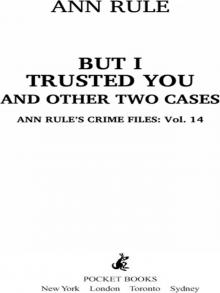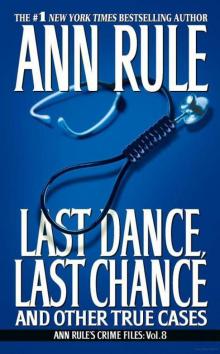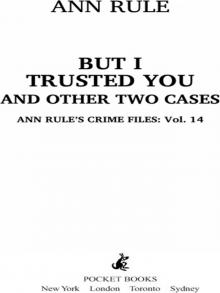Kiss Me, Kill Me and Other True Cases Read online
Page 5
Al Schrader had a theory of his own, gleaned from scores of interviews he had had with LSD users. Rarely seen today, it was a popular drug of the era, mind altering and unpredictable, and the story persisted that Sandy had known people who experimented with the hallucinogenic once espoused by Dr. Timothy Leary, Cary Grant, and even the Beatles.
“Many users have told me that LSD can bring on a kind of compulsive behavior,” Schrader said. “That is, once an idea forms in a drug-induced state, they must complete the whole sequence. It is possible that could account for Sandy Bowman’s being stabbed almost sixty times. The killer, once started, may have had some drug-charted pattern to complete.
“Maybe the murderer himself doesn’t know he is a killer. Or it may be that deep in the subconscious of that person’s mind, the memory of that ‘bad trip’ lies buried and could surface at any time. We don’t know. It’s only a theory.”
That theory seemed to be a much more viable possibility in 1969 than it did as time passed.
The Seattle Homicide Unit has had an enviable closure record on murder cases for decades, successfully charging suspects in over 85 per cent of their investigations. Back in the sixties and seventies, there were usually between forty-five and sixty homicides a year within the city’s borders, a figure that hasn’t changed over the years. Like most major cities, suburbs have attracted massive migrations. When I began as the Northwest correspondent for fact-detective magazines in 1969, King County, excluding Seattle, rarely had more than one or two murders a year. Today, the county homicide rate keeps pace with the city’s.
In the Seattle Police Department, unsolved cases were worked and reworked until there were no more avenues to explore, and then they tended to drift to Archives, where they were seldom read. That wasn’t the case with Sandy Bowman’s unsolved murder. Although most of the detectives who tried to find Sandy’s killer retired over the years, younger investigators coming into the unit were briefed on the case. Still, as years—and then decades—passed, it seemed as though Sandy’s murder would never be avenged. As they worked beside Jerry Yates, the veteran detectives and the young men coming up were continually reminded of their failure to bring some kind of justice to this man who was their coworker, whom they admired as a good cop who had comforted so many other families, but who could not tell his own parents and sisters why someone would kill his sweet teenaged niece.
Sandy’s family dealt with losing her the best way they could. Her mother did her crying in private; she refused to discuss Sandy at all. Losing her beloved daughter and the grandchild she had hoped for was too painful to talk about out loud.
The family decided not to tell Sandy’s grandfather about Sandy’s murder. He was elderly and frail and they were afraid the truth would kill him. “When she was killed,” her cousin Rita Gillis recalled, “no one was allowed to talk about her. To my knowledge, no one ever told my grandfather she was dead. They told him she got married and moved away.”
Benjamin Yates died in 1977 without ever knowing that his favorite granddaughter had been murdered.
• • •
Inevitably, the names of newer cases were written on the charts in the captain’s office, a little cubicle in the northeast corner of the cramped Homicide Unit. Although I wrote factual articles about almost every case listed, I never forgot Sandy Bowman.
9
Shortly after Sandy Bowman’s name faded from the headlines and slipped to the back pages of The Seattle Post-Intelligencer and The Seattle Times, and finally vanished completely, a series of abductions of young women captured the public’s interest. In a sense, they were more baffling than Sandy’s murder because no one knew what had happened to them for a long time.
Mary Annabelle Bjornson was 21 years old when she disappeared on January 4, 1969, only two and a half weeks after Sandy’s death, but the circumstances of her vanishing were unlike the M.O. in Sandy’s case.
The relatively new I-5 freeway was the direct route from downtown Seattle to the University of Washington and then north to Everett, Mt. Vernon, Bellingham, and Canada. It crossed over the University Bridge above the Lake Washington Ship Canal. As cars approached the north end of the bridge, they could look down and see two rectangular apartment buildings that sat side by side on N.E. 42nd Street below. Painted beige and brown since they were built in the twenties or thirties, the twin structures each had several apartments on three floors. They were stodgy compared to newer buildings that featured brick or sandstone and individual balconies and patios, but the apartments had big, airy rooms and lots of windows. Their location beneath the bridge was handy for residents, close to the University, the shores of the ship canal, and to bus stops. And the rent was a bargain. Few units were empty for long.
Mary Annabelle wasn’t a student; she had an entry-level job. She was an extremely attractive young woman, quite tall and slender with lovely features. But it was her hair that people remembered: it was dark brown, long, very thick and wavy, and she parted it in the middle so that it framed her face like a cloud.
In one of the bleak coincidences that often mark homicide cases, Mary Annabelle was also the niece of a Seattle police detective. Her aunt “B.J.” Bjornson was one of the last of the oldtime policewomen who had been hired early on to act more as matrons who dealt with women prisoners than as investigators. B.J. was tall, too, and stocky, with several feet of braids wound around her head. She may have been Mary Annabelle’s great-aunt because she was well into her sixties when her niece disappeared, but they were very fond of one another.
B.J. Bjornson worked in the Crimes Against Persons Unit, as Jerry Yates did, but her assignment was “Mental Cases,” as they were called then. She had a steady, calm presence and she could make even the most disturbed person brought in by the uniformed officers feel safe.
Mary Annabelle had plans for the Saturday night of January 4, 1969. She had invited her date for a home-cooked dinner and then they were going dancing at the Civic Center, where a West Indies band was playing. She loved calypso and reggae, and her date, Duane Thornton,* was one of her favorites.
Duane was due for dinner between 8:30 and 9:00, and Mary Annabelle had dinner in the oven and simmering on the stove while she changed into her pink chiffon dress and white high-heeled shoes.
She had made a lot of friends in the apartment house under the bridge and Mary Annabelle dropped in to see Don Simmer about 8:00 that Saturday night. He was expecting dinner guests himself—three friends.
“Some guy came by my place a few minutes ago,” she said. “He was looking for Steve. He must have meant Steve Shelton, Linda Williams’s friend.”
Linda lived in an apartment a floor above Mary Annabelle’s and Don’s floor, and she dated Steve Shelton. “I told him how to find Linda’s apartment,” Mary Annabelle said, “and he went up there and came back and said Linda wasn’t home.”
The stranger had asked for a pencil and a piece of paper so he could leave a note on Linda Williams’s door, and Mary Annabelle had given them to him. Within a few minutes, he returned yet a third time to tell Mary Annabelle that he had left the note and would be back in about an hour.
Don Simmer said that she didn’t seem concerned about the stranger, but thought it was a little odd that he kept coming back. When Simmer asked what the man looked like, she said he was young and quite “husky.” He had worn a blue Navy pea jacket.
Mary Annabelle had visited with Simmer until about 8:30 and then she left, telling him she had things cooking on the stove that she had to check on.
About fifteen minutes later, he heard someone knocking on her door. She must have opened it because he heard it closing. And shortly after, he heard it close again.
Since Mary Annabelle had been expecting Duane Thornton for dinner, Simmer thought nothing of it. But when Thornton arrived for his date with Mary Annabelle at five minutes after nine, she wasn’t there. Her door was unlocked, the curtains were open, and there was food cooking on the stove. Three of the burners and the oven were
on, and some of the food was beginning to stick to the bottom of the pans.
He turned the burners down and sat down to wait. Then he assumed that Mary Annabelle must have gone next door to visit with Simmer, so Duane went over there.
“She was here,” Don Simmer said, “but she left about 8:30 to finish cooking. She’s probably close by.”
Duane Thornton went back to Mary Annabelle’s apartment to wait for her, listening to music on the stereo. When minutes passed with no sign of her, he walked nervously around her kitchen. He noticed a piece of note paper with a sketch on it on her kitchen table. It looked like her writing and he could tell it was a drawing of her building with an upstairs apartment marked. He recognized the location as Linda Williams’s apartment.
But Mary Annabelle knew where Linda lived. Why would she need a map to it? When Duane asked Don Simmer about it, he told Duane about the stranger who had made three stops at Mary Annabelle’s apartment looking for a “Steve.”
The minutes stretched into an hour. When there was no sign of Mary Annabelle by 10:30, Thornton and Simmer were very concerned. They looked through every room in her small place and found her purse was still in her bedroom. Her cigarettes were on the kitchen table along with the diagram to Linda’s apartment. Even her coat was still there.
But Mary Annabelle was gone. The two men called Seattle Police.
The missing young woman had probably been in her apartment, safe, until at least 8:45, when Simmer heard her door shut for the second time. Why she had left on a winter’s night without her coat, purse, or cigarettes was the baffling question. She had no plans to go anywhere without her date, and at 8:45 he was due any moment. Whoever had knocked on her door, she would have expected to see Duane Thornton.
As for the husky young man in the Navy peacoat, no one other than Mary Annabelle had seen him.
“Would she have left with a stranger?” the patrol officer asked her friends.
“I don’t think so,” Simmer said. “She’s the kind of a girl who will go out of her way to do a favor for someone, but she was pretty trusting. She opened her door several times when that guy knocked on her door. She just assumed he was looking for a friend of ours. I wish now that I asked her if she knew his name or if he had a car—or something. But it seemed like such an ordinary thing, except that he kept coming back.”
It would have been easy for Mary Annabelle to feel secure. Simmer was right next door, and his friends would be coming down the hall at any moment, along with her own date.
But something must have happened to her. A search of the two apartment buildings came up empty. Nobody had seen her. She wasn’t locked in the basement, or in any storage area.
Her disappearance was reminiscent of a scary movie where a secret door opens in a wall and an arm reaches out and pulls a beautiful young woman inside. Mary Annabelle was just gone.
Music still played in her apartment and the smell of the meal she had been cooking lingered.
Because she was an adult and because there was no sign of foul play, the police couldn’t take even a missing-persons complaint until forty-eight hours had passed. Maybe she had had her own reasons to stand up her date, although Simmer and Duane Thornton were sure she wouldn’t have done that.
Maybe a friend with a problem had called her and she had rushed out to comfort them.
And there was always the possibility that she had staged her own disappearance, setting it up by telling Don Simmer about the “stranger” in the peacoat. As I write this, there are scores of young women missing all over America, but there are also several who vanished on purpose, faking an “abduction” to get attention from a reluctant boyfriend or because they were failing their college classes and wanted to avoid final exams.
People sometimes behave in strange ways.
Again, a Seattle Crimes Against Persons detective had close ties to a young woman who was almost certainly in danger. Investigators had to wonder if there was someone out there with a grudge against their unit. But who would even know all the relatives of the detectives? Mary Annabelle had the same last name as B.J. Bjornson, but it would have taken someone intimately acquainted with the Yateses’ extended family to know that Sandy Bowman was Jerry Yates’s niece.
It had to be simple tragic coincidence.
Mary Annabelle didn’t show up at her job on Monday morning, January 6, 1969, and she never came back to her apartment. No one who knew her ever heard from her again. She became one of the dozens of missing persons in Jerry Yates’s files, and both his crew and the homicide detectives continued to work on the mystery of her disappearance.
10
Lynne Tuski was 20 in January 1969, and a junior at the University of Washington. Her shining blond hair was cut short and framed her face. She wore glasses with oversized tortoiseshell frames. Like Mary Annabelle, Lynne was very attractive, but she was a totally different type, studious looking when she wore glasses, but with a model’s slim figure. Lynne worked part-time at the Sears department store on Aurora Avenue in the north end of Seattle.
She worked on the snowy Saturday evening January 25, exactly three weeks after Mary Annabelle’s disappearance. Lynne had her own car, and after the store closed at nine, she was last seen walking toward it in the Sears parking lot. The lot was well lighted but relatively empty. Lynne usually walked out with other employees, but on this Saturday night she was anxious to get home. She carried her car keys in her hand so she could open her door quickly and hop in.
The temperature was dropping rapidly and more snow was piling up. Although Aurora Avenue is one of Seattle’s main arterials, the hills on the side streets quickly become treacherous when it snows.
Lynne Tuski disappeared from sight as she walked into the swirling snow.
No one ever saw her alive again. No one heard a cry for help or a sudden scream. Her car was in the parking lot when her friends and family started looking for her. It was still locked, just as she had left it.
• • •
Neither Mary Annabelle nor Lynne was the kind of girl to run away. But they were gone, nevertheless, and as the weeks went by, both the police and the news media spoke of them in the same breath.
Whom had they encountered on two Saturday nights in January? Both had gone missing about nine o’clock at night. Neither had ever spoken of being afraid of anyone. Intense questioning of their friends and family by Seattle Police investigators failed to turn up a suspect or suspects.
Or an eyewitness.
Or a motive for their disappearance.
There were no ransom notes.
That left the dread conclusion that a complete stranger had watched and waited for a pretty girl who suited his purpose, and that purpose was almost surely rape.
While it was true that the young women who were missing had disappeared in the same general area of Sandy Bowman’s violent murder, there were many dissimilarities too.
The most glaring difference was that Sandy was killed where she lived and the scene was very bloody. Someone had obviously rifled through the contents of her purse, dumping it on the floor. Mary Annabelle’s purse hadn’t been touched. There was no sign of a struggle in the Bjornson apartment, or in the Sears parking lot where Lynne Tuski was last seen.
Until the missing girls were located, there was no way to compare their fates with that of Sandy Bowman.
11
On February 21, another University of Washington student disappeared. Connie Stanton* had agreed to meet her brother, John, who was a Navy officer, at her apartment. They planned to leave that Friday afternoon on a trip to their hometown of Leavenworth, Washington. Leavenworth is a quaint small town where tourists come to see the Bavarian buildings along its main street. It is apple country, close to Wenatchee on the eastern side of the Cascade Mountains. The northern approach to Leavenworth is over Stevens Pass or it can be reached by crossing Snoqualmie Pass and then Blewett Pass. But either way drivers chose, they needed chains for their tires and experience driving in snow and ic
e. Connie would never have attempted the trip without her brother as the driver.
Still, when John Stanton* and his wife arrived to pick his sister up between three and four in the afternoon, she wasn’t in her apartment. She was a predictable, punctual, and considerate young woman, so much so that her brother and sister-in-law were instantly alarmed. Connie was always where she said she would be.
Stanton knocked on the doors of neighboring apartments and learned from a man who knew Connie that he had seen her leave the day before with a man driving a white station wagon.
“Did she come back?” Stanton asked.
“I don’t know. We haven’t seen her since then.”
“What did he look like?” Stanton asked, immediately concerned.
The neighbor said that the man was about 25, broad shouldered and strong looking, with a haircut that failed to tame several cowlicks. “He looked like he’d just walked through a high wind,” the man said. “I got the impression your sister knew him. She called him John.”
That was enough for John Stanton and his wife. He had to be talking about a casual friend of the Stantons who had attended high school with them in Leavenworth: John Canaday. Canaday had been a sports hero in high school. He had recently been divorced from one of Connie’s closest friends, and he wasn’t taking it well. He and his ex-wife had two small children, but they hadn’t been able to hold their marriage together after Canaday returned from serving in the Navy in Vietnam.
Connie had mentioned that Canaday was living with his parents in the north end of Seattle, and working for the Seattle Water Department. He had called her to talk a few times. He had even visited her, and she felt sorry for him because he wanted to reconcile with his wife, and Connie knew that wasn’t likely to happen.
John Stanton knew his sister: Connie was naive, too sympathetic, and very inexperienced with the world. As far as he knew, she had never dated anyone seriously. If Canaday was using her as a sounding board or as a way to get his wife back, Connie’s natural kindness would have kicked in. But leave with him, and be gone all night? That didn’t sound like Connie.

 Too Late to Say Goodbye: A True Story of Murder and Betrayal
Too Late to Say Goodbye: A True Story of Murder and Betrayal Green River, Running Red
Green River, Running Red Bitter Harvest
Bitter Harvest Dead by Sunset: Perfect Husband, Perfect Killer?
Dead by Sunset: Perfect Husband, Perfect Killer? Lust Killer
Lust Killer And Never Let Her Go: Thomas Capano: The Deadly Seducer
And Never Let Her Go: Thomas Capano: The Deadly Seducer But I Trusted You and Other True Cases
But I Trusted You and Other True Cases Smoke, Mirrors, and Murder and Other True Cases
Smoke, Mirrors, and Murder and Other True Cases If You Really Loved Me
If You Really Loved Me Kiss Me, Kill Me and Other True Cases
Kiss Me, Kill Me and Other True Cases Fatal Friends, Deadly Neighbors and Other True Cases
Fatal Friends, Deadly Neighbors and Other True Cases Practice to Deceive
Practice to Deceive Mortal Danger and Other True Cases
Mortal Danger and Other True Cases Without Pity: Ann Rule's Most Dangerous Killers
Without Pity: Ann Rule's Most Dangerous Killers Everything She Ever Wanted
Everything She Ever Wanted A Fever in the Heart and Other True Cases
A Fever in the Heart and Other True Cases In the Still of the Night
In the Still of the Night LAST DANCE, LAST CHANCE - and Other True Cases
LAST DANCE, LAST CHANCE - and Other True Cases A Rage to Kill
A Rage to Kill The I-5 Killer
The I-5 Killer The Stranger Beside Me
The Stranger Beside Me Everything She Ever Wanted: A True Story of Obsessive Love, Murder, and Betrayal
Everything She Ever Wanted: A True Story of Obsessive Love, Murder, and Betrayal But I Trusted You
But I Trusted You Without Pity
Without Pity Kiss Me, Kill Me
Kiss Me, Kill Me Too Late to Say Goodbye
Too Late to Say Goodbye Lying in Wait
Lying in Wait Fatal Friends, Deadly Neighbors
Fatal Friends, Deadly Neighbors A Rage to Kill: And Other True Cases
A Rage to Kill: And Other True Cases And Never Let Her Go
And Never Let Her Go Lying in Wait Ann Rule's Crime Files Vol.17
Lying in Wait Ann Rule's Crime Files Vol.17 Blood Secrets: Chronicles of a Crime Scene Reconstructionist
Blood Secrets: Chronicles of a Crime Scene Reconstructionist No Regrets
No Regrets Mortal Danger
Mortal Danger But I Trusted You: Ann Rule's Crime Files #14
But I Trusted You: Ann Rule's Crime Files #14 Empty Promises
Empty Promises Dead by Sunset
Dead by Sunset Last Dance, Last Chance
Last Dance, Last Chance Don't Look Behind You
Don't Look Behind You